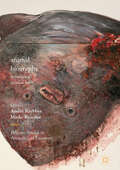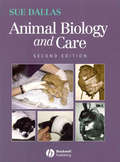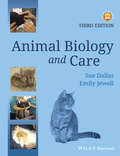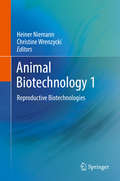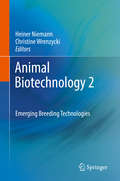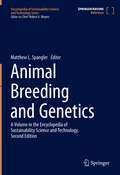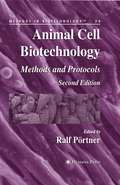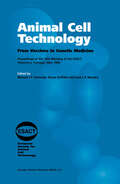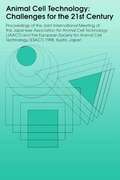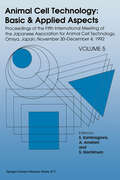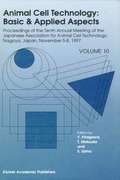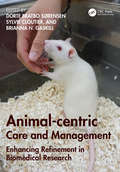- Table View
- List View
Animal Behaviour and Drug Action (Novartis Foundation Symposia #957)
by Hannah Stienberg A. V. S. De Reuck Julie KnightThe Novartis Foundation Series is a popular collection of the proceedings from Novartis Foundation Symposia, in which groups of leading scientists from a range of topics across biology, chemistry and medicine assembled to present papers and discuss results. The Novartis Foundation, originally known as the Ciba Foundation, is well known to scientists and clinicians around the world.
Animal Biography: Re-framing Animal Lives (Palgrave Studies in Animals and Literature)
by André Krebber Mieke RoscherWhile historiography is dominated by attempts that try to standardize and de-individualize the behavior of animals, history proves to be littered with records of the exceptional lives of unusual animals. This book introduces animal biography as an approach to the re-framing of animals as both objects of knowledge as well as subjects of individual lives. Taking an interdisciplinary perspective and bringing together scholars from, among others, literary, historical and cultural studies, the texts collected in this volume seek to refine animal biography as a research method and framework to studying, capturing, representing and acknowledging animal others as individuals. From Heini Hediger’s biting monitor, Hachikō and Murr to celluloid ape Caesar and the mourning of Topsy’s gruesome death, the authors discuss how animal biographies are discovered and explored through connections with humans that can be traced in archives, ethological fieldwork and novels, and probe the means of constructing animal biographies from taxidermy to film, literature and social media. Thus, they invite deeper conversations with socio-political and cultural contexts that allow animal biographies to provide narratives that reach beyond individual life stories, while experimenting with particular forms of animal biographies that might trigger animal activism and concerns for animal well-being, spur historical interest and enrich the literary imagination.
Animal Biology and Care
by Sue DallasFollowing the success of the first edition, this new edition has been expanded to include more information on small mammals, birds and fish. Intended as a foundation text for those on animal care, nurse auxiliary and veterinary care assistant courses, it introduces essential theoretical background information and clearly outlines the practical skills necessary when embarking on the care of any animal. Designed specifically to meet the requirements of animal care, pre-veterinary nursing auxiliary and care students; Provides basic training in animal biology and care, with particular attention given to those subjects that students find difficult to understand, such as anatomy and physiology; New chapter additions on fish and birds. Clearly and simply laid out, with over 150 illustrations, Animal Biology and Care 2e will be invaluable to all those training or working in animal care.
Animal Biology and Care
by Sue DallasFollowing the success of the first edition, this new edition has been expanded to include more information on small mammals, birds and fish. Intended as a foundation text for those on animal care, nurse auxiliary and veterinary care assistant courses, it introduces essential theoretical background information and clearly outlines the practical skills necessary when embarking on the care of any animal. Designed specifically to meet the requirements of animal care, pre-veterinary nursing auxiliary and care students; Provides basic training in animal biology and care, with particular attention given to those subjects that students find difficult to understand, such as anatomy and physiology; New chapter additions on fish and birds. Clearly and simply laid out, with over 150 illustrations, Animal Biology and Care 2e will be invaluable to all those training or working in animal care.
Animal Biology and Care
by Sue Dallas Emily JewellThe perfect study companion, Animal Biology and Care, 3rd Edition is specifically designed for students on animal care, animal nursing assistant and veterinary care assistant courses. This edition is fully updated with new course content, a refreshed design and colour illustrations throughout. Basic biological theory is introduced with diagrams for visual learners while photographs demonstrate the common practical procedures carried out by animal care assistants. Key features include: New content on exotic species, recognising the increasing number of these animals kept as pets. Extensive coverage of the Animal Welfare Act 2006 and recent advances in animal welfare. Written in line with course curricula, chapter summaries help you to remember key points and learning objectives. A companion website has interactive MCQs to help you test your knowledge. Divided into three main sections covering animal science and genetics, health and husbandry and nursing procedures, this book will help lay the foundations for a successful career in animal care and management!
Animal Biology and Care
by Sue Dallas Emily JewellThe perfect study companion, Animal Biology and Care, 3rd Edition is specifically designed for students on animal care, animal nursing assistant and veterinary care assistant courses. This edition is fully updated with new course content, a refreshed design and colour illustrations throughout. Basic biological theory is introduced with diagrams for visual learners while photographs demonstrate the common practical procedures carried out by animal care assistants. Key features include: New content on exotic species, recognising the increasing number of these animals kept as pets. Extensive coverage of the Animal Welfare Act 2006 and recent advances in animal welfare. Written in line with course curricula, chapter summaries help you to remember key points and learning objectives. A companion website has interactive MCQs to help you test your knowledge. Divided into three main sections covering animal science and genetics, health and husbandry and nursing procedures, this book will help lay the foundations for a successful career in animal care and management!
Animal Biotechnology 1: Reproductive Biotechnologies
by Heiner Niemann Christine WrenzyckiThis two-volume textbook provides a comprehensive overview on the broad field of Animal Biotechnology with a special focus on livestock reproduction and breeding. The reader will be introduced to a variety of state-of-the-art technologies and emerging genetic tools and their applications in animal production. Also, ethics and legal aspects of animal biotechnology will be discussed and new trends and developments in the field will be critically assessed. The two-volume work is a must-have for graduate students, advanced undergraduates and researchers in the field of veterinary medicine, genetics and animal biotechnology.This first volume mainly focuses on artificial insemination, embryo transfer technologies in diverse animal species and cryopreservation of oocytes and embryos.
Animal Biotechnology 2: Emerging Breeding Technologies
by Heiner Niemann Christine WrenzyckiThis two-volume textbook provides a comprehensive overview on the broad field of Animal Biotechnology with a special focus on livestock reproduction and breeding. The reader will be introduced to a variety of state-of-the-art technologies and emerging genetic tools and their applications in animal production. Also, ethics and legal aspects of animal biotechnology will be discussed and new trends and developments in the field will be critically assessed. The two-volume work is a must-have for graduate students, advanced undergraduates and researchers in the field of veterinary medicine, genetics and animal biotechnology.This second volume is dedicated to genetic tools in animal biotechnology such as somatic cloning, transgenic technologies and the application of stem cells in livestock breeding. Also, ethics and legal aspects are discussed.
Animal Breeding and Genetics (Encyclopedia Of Sustainability Science And Technology Ser.)
by Matthew L. SpanglerAnimal Cell Biotechnology: Methods and Protocols (Methods in Biotechnology #24)
by Ralf PörtnerThe second edition of this book constitutes a comprehensive manual of new techniques for setting up mammalian cell lines for production of biopharmaceuticals, and for optimizing critical parameters for cell culture considering the whole cascade from lab to final production. The chapters are written by world-renowned experts and the volume’s five parts reflect the processes required for different stages of production. This book is a compendium of techniques for scientists in both industrial and research laboratories that use mammalian cells for biotechnology purposes.
Animal Cell Biotechnology: Methods and Protocols (Methods in Molecular Biology #2095)
by Ralf PörtnerAnimal Cell Biotechnology: Methods and Protocols, Fourth Edition constitutes a comprehensive manual of state-of-the-art techniques for setting up mammalian cell lines and media for development of biopharmaceuticals, and optimizing critical parameters for cell culture considering the whole cascade from the lab to the final production. Special emphasis was put on model-assisted concepts. Scientists with long-refined expertise describe cutting-edge techniques for the production of therapeutic proteins and vaccines. Capturing the major advances that have occurred in both science and the technology of these biopharmaceuticals, this important book covers the powerful new techniques used in cell line and media development, optimizing process techniques and process strategies, use of model-assisted tools for process design and optimization, and in analysis. Topics include cell line and media development, techniques for process development, model-based techniques for process development, process analysis, and downstream techniques. The volume is divided into five parts that reflect the processes required for different stages of production. Written in the highly successful Methods in Molecular Biology series format, chapters include introductions to their respective topics, lists of the necessary materials and reagents, step-by-step, readily reproducible laboratory protocols, and tips on troubleshooting and avoiding known pitfalls.Animal Cell Biotechnology: Methods and Protocols, Fourth Edition provides a compendium of techniques for scientists in industrial and research laboratories that use mammalian cells for biotechnology purposes.
Animal Cell Culture (Cell Engineering #9)
by Mohamed Al-RubeaiAnimal cells are the preferred “cell factories” for the production of complex molecules and antibodies for use as prophylactics, therapeutics or diagnostics. Animal cells are required for the correct post-translational processing (including glycosylation) of biopharmaceutical protein products. They are used for the production of viral vectors for gene therapy. Major targets for this therapy include cancer, HIV, arthritis, cardiovascular and CNS diseases and cystic fibrosis. Animal cells are used as in vitro substrates in pharmacological and toxicological studies. This book is designed to serve as a comprehensive review of animal cell culture, covering the current status of both research and applications. For the student or R&D scientist or new researcher the protocols are central to the performance of cell culture work, yet a broad understanding is essential for translation of laboratory findings into the industrial production. Within the broad scope of the book, each topic is reviewed authoritatively by experts in the field to produce state-of-the-art collection of current research. A major reference volume on cell culture research and how it impacts on production of biopharmaceutical proteins worldwide, the book is essential reading for everyone working in cell culture and is a recommended volume for all biotechnology libraries.
Animal Cell Culture and Technology (THE BASICS (Garland Science))
by Michael ButlerAnimal cell culture is an important laboratory technique in the biological and medical sciences. It has become an essential tool for the study of most biochemical and physiological processes and the use of large-scale animal cell culture has become increasingly important to the commercial production of specific compounds for the pharmaceutical industry. This book describes the basic requirements for establishing and maintaining cell cultures both in the laboratory and in large-scale operations. Minimal background knowledge of the subject is assumed and therefore it will be a readable introduction to animal cell culture for undergraduates, graduates and experienced researchers. Reflecting the latest developments and trends in the field, the new topics include the latest theory of the biological clock of cell lines, the development of improved serum-free media formulations, the increased understanding of the importance and control of protein glycosylation, and the humanization of antibodies for therapeutic use.
Animal Cell Culture and Technology (THE BASICS (Garland Science))
by Michael ButlerAnimal cell culture is an important laboratory technique in the biological and medical sciences. It has become an essential tool for the study of most biochemical and physiological processes and the use of large-scale animal cell culture has become increasingly important to the commercial production of specific compounds for the pharmaceutical industry. This book describes the basic requirements for establishing and maintaining cell cultures both in the laboratory and in large-scale operations. Minimal background knowledge of the subject is assumed and therefore it will be a readable introduction to animal cell culture for undergraduates, graduates and experienced researchers. Reflecting the latest developments and trends in the field, the new topics include the latest theory of the biological clock of cell lines, the development of improved serum-free media formulations, the increased understanding of the importance and control of protein glycosylation, and the humanization of antibodies for therapeutic use.
Animal Cell Culture Techniques (Springer Lab Manuals)
by Martin ClynesCell culture techniques allow a variety of molecular and cell biological questions to be addressed, offering physiological conditions whilst avoiding the use of laboratory animals. In addition to basic techniques, a wide range of specialised practical protocols covering the following areas are included: cell proliferation and death, in-vitro models for cell differentiation, in-vitro models for toxicology and pharmacology, industrial application of animal cell culture, genetic manipulation and analysis of human and animal cells in culture.
Animal Cell Technology: From Vaccines to Genetic Medicine
by Manuel J. T. Carrondo Bryan Griffiths José L. P. MoreiraAnimal cell technology has undergone a rapid transformation over the last decade from a research tool and highly specialised technology to a central resource for innovation in pharmaceutical research and development. These proceedings of the 14th Meeting of the European Society for Animal Cell Technology (Vilamoura, Portugal, May 1996) bring up to date the historical perspective of animal cell technology for the benefit of society, `From Vaccines to Genetic Medicine', and will charter this vital technology for the years to come. Strong contributions are grouped in the traditional ESACT areas of 'Cell and Physiology Engineering' dealing with cell state, including genetics, and its environment, and 'Animal Cell Process Engineering' covering integration of bioreaction with bioseparation coupled with on-line monitoring to improve protein production and consistency. Extensive coverage of metabolic engineering on synthesis, folding, assembly, transiting and secretion is dealt with in the session on 'Recombinant Proteins: Biosynthesis and Bioprocessing'. Two traditional but expanding areas of animal cell technology relevance are highlighted in the broad sessions of 'Animal Cells as Tools for Discovery and Testing' and 'Animal Cell Vaccines: Present and Future'. Two sessions finally cover the more recent domains of animal cell technology work - 'Tissue Engineering and Biomedical Devices' and 'Cells and Vectors for Genetic Medicine' - where one can foresee a very bright future.
Animal Cell Technology: Proceedings of the Seventeenth Annual Meeting of the Japanese Association for Animal Cell Technology (JAACT), Nagoya, Japan, November 15-18, 2004 (Animal Cell Technology: Basic & Applied Aspects #14)
by Shinji Iijima Ken-Ichi NishijimaComplete updates of rapidly expanding fields of animal cell technology Covers all topics from academic to industrial matters
Animal Cell Technology: Proceedings of the 19th Annual Meeting of the Japanese Association for Animal Cell Technology (JAACT), Kyoto, Japan, September 25-28, 2006 (Animal Cell Technology: Basic & Applied Aspects #15)
by Koji Ikura Masaya Nagao Akira Ichikawa Kiichiro Teruya Sanetaka ShirahataAnimal cell technology is a growing discipline of cell biology which aims not only to understand structures, functions and behaviors of differentiated animal cells, but also to ascertain their abilities to be used for industrial and medical purposes. The goal of animal cell technology includes the clonal expansion of differentiated cells, the optimization of their culture conditions, modulation of their ability to produce proteins of medical and pharmaceutical importantance, and the application of animal cells to gene therapy, artificial organs and the production of functional foods. This volume gives the readers a complete review of the present state-of-the-art and will be useful for those working in either academic environments or in the biotechnology and pharmaceutical sectors, particularly cell biologists, biochemists, molecular biologists, immunologists, biochemical engineers and all other disciplines related to animal cell culture.
Animal Cell Technology: Proceedings of the joint international meeting of the Japanese Association for Animal Cell Technology (JAACT) and the European Society for Animal Cell Technology (ESACT) 1998, Kyoto, Japan
by Kouji Ikura Seiji Masuda Masaya Nagao Ryuzo SasakiAnimal cell technology aims to understand structures, functions, and behaviors of differentiated animal cells and to ascertain their abilities to be used in industrial and medical purposes. This volume gives readers a complete review of the present state of the art in Japan.
Animal Cell Technology: Proceedings of the Fifth International Meeting of the Japanese Association for Animal Cell Technology, Omiya, Japan, November 30–December 4, 1992 (Animal Cell Technology: Basic & Applied Aspects #5)
by S. Kaminogawa A. Ametani S. HachimuraAnimal cell technology has been making tremendous progress. Originally this term reminded people of engineering for high density and large volume culture of animal cells. At present many fields of biological sciences are aiming at advance in animal cell technology. Cell culture engineering is aided not only with developments in apparatus, matrix, media, and computational analysis, but also with new biological procedures in gene and protein technology, cell biological resources and immunological methods. Results obtained with animal cell technology are applied to production of pharmaceuticals, diagnosis reagents and food endowed with physiological functions, and cell and gene therapy of animals and humans, and useful for elucidating scientific phenomena. It is also essential to establish methods of evaluation for functionality and safety of newly discovered molecules and cells. The progress in animal cell technology is supported by, and attributes in both of basic and applied sciences. The proceedings of the Fifth International Meeting of the Japanese Association for Animal Cell Technology (JAACT) covers the subjects above mentioned. The articles in this book will help researchers in many fields to understand the current status and future trends in animal cell technology. JAACT organized this Meeting and we express our gratitude to the members of JAACT. We gratefully acknowledge all the members of the organizing committee for their dedication in assuring the Meeting's success. For their valuable supports, we also thank the Japanese Biolndustry Association and Saitama Foundation for Culture and Industry.
Animal Cell Technology: Proceedings of the Tenth Annual Meeting of the Japanese Association for Animal Cell Technology, Nagoya, November 5–8, 1997 (Animal Cell Technology: Basic & Applied Aspects #1)
by Y. Kitagawa T. Matsuda S. IijimaAnimal cell technology is a growing discipline of cell biology which aims not only to understand structures, functions and behaviors of differentiated animal cells but also to ascertain their abilities to be used for industrial and medical purposes. The goal of animal cell technology includes accomplishments of clonal expansion of differentiated cells with useful ability, optimization of their culture conditions, modulation of their ability for production of medically and pharmaceutically important proteins, and the application of animal cells to gene therapy and artificial organs. This Volume gives the readers a complete review of the present state of the art in Japan. The Proceedings will be useful for cell biologists, biochemists, molecular biologists, immunologists, biochemical engineers and other disciplines related to animal cell culture, working either in academic environments or in industries of biotechnology and pharmacy.
Animal-centric Care and Management: Enhancing Refinement in Biomedical Research
by Dorte Bratbo Sørensen, Sylvie Cloutier, and Brianna N. GaskillThe concept of the 3Rs (Refinement, Reduction and Replacement) has been used as a framework for improving the welfare of laboratory animals for the last half century. By establishing an animal-centric view on housing and management, Animal-centric Care and Management: Enhancing Refinement in Biomedical Research takes Russell and Burch’s definition of Refinement as "elimination of inhumanities" and goes further. Rather than fitting animals into experimental conditions, it encourages readers to adjust conditions to better meet the behavioral, emotional, physical, and physiological needs and preferences of the animals. The team of expert authors, from the fields of laboratory animal science, ethology, biology as well as animal training, provide ideas for creating housing conditions and handling procedures that induce, to the best of current abilities and knowledge, a long-term positive state of mind in the animals under our care. This book is written for animal caretakers, animal health technicians, researchers, animal facility managers, laboratory animal veterinarians, and anyone who engages in work with living experimental animals or is interested in the continuous improvement of laboratory animal welfare. This interdisciplinary guide will act as a catalyst, resulting in multiple viewpoints and fields collaborating to optimize laboratory animal welfare.
Animal-centric Care and Management: Enhancing Refinement in Biomedical Research
by Dorte Bratbo Sørensen Sylvie Cloutier Brianna N. GaskillThe concept of the 3Rs (Refinement, Reduction and Replacement) has been used as a framework for improving the welfare of laboratory animals for the last half century. By establishing an animal-centric view on housing and management, Animal-centric Care and Management: Enhancing Refinement in Biomedical Research takes Russell and Burch’s definition of Refinement as "elimination of inhumanities" and goes further. Rather than fitting animals into experimental conditions, it encourages readers to adjust conditions to better meet the behavioral, emotional, physical, and physiological needs and preferences of the animals. The team of expert authors, from the fields of laboratory animal science, ethology, biology as well as animal training, provide ideas for creating housing conditions and handling procedures that induce, to the best of current abilities and knowledge, a long-term positive state of mind in the animals under our care. This book is written for animal caretakers, animal health technicians, researchers, animal facility managers, laboratory animal veterinarians, and anyone who engages in work with living experimental animals or is interested in the continuous improvement of laboratory animal welfare. This interdisciplinary guide will act as a catalyst, resulting in multiple viewpoints and fields collaborating to optimize laboratory animal welfare.
Animal Cognition and Sequential Behavior: Behavioral, Biological, and Computational Perspectives
by Stephen B. Fountain Michael D. Bunsey Joseph H. Danks Michael K. McBeathAnimal Cognition and Sequential Behavior: Behavioral, Biological, and Computational Perspectives brings together psychologists studying cognitive skill in animal and human subjects, connectionist theorists, and neuroscientists who have a common interest in understanding function and dysfunction in the realm of complex cognitive behavior. In this volume, discussion focuses on behavioral, cognitive, psychobiological, and computational approaches to understanding the integration of ongoing behavior, with particular attention to models of timing and the organization of sequential behavior.
Animal Coronaviruses (Springer Protocols Handbooks)
by Leyi WangThis detailed volume provides diagnosticians and researchers with practical methodologies and approaches to tackle animal coronaviruses. It explores conventional immunohistochemistry, virus neutralization, enzyme-linked immunosorbent assays, expression and purification of recombinant viral proteins, and various molecular assays, including conventional and real-time reverse transcription-PCR, reverse genetics methodology, and next generation sequencing and sequence analyses. As part of the Springer Protocols Handbooks series, chapters contain readily reproducible laboratory protocols as well as expert tips on troubleshooting and avoiding known pitfalls. Practical and authoritative, Animal Coronaviruses serves as an ideal reference for researchers examining a wide variety of coronavirus species in the Coronaviridae.

